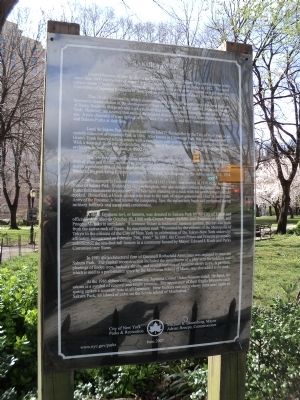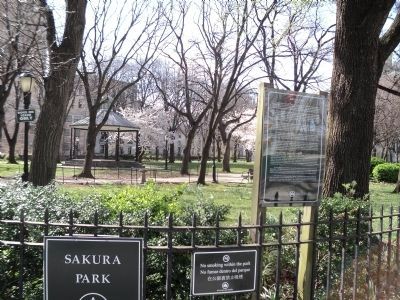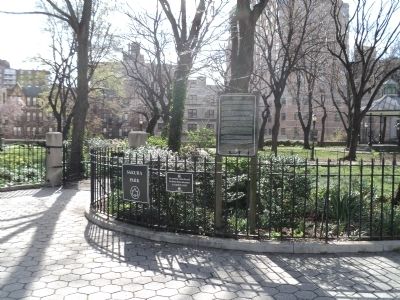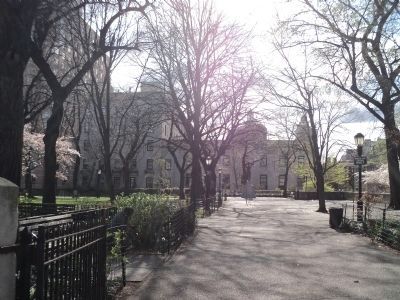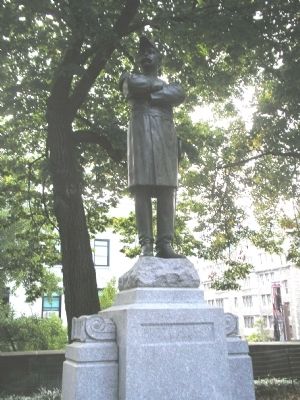Morningside Heights in Manhattan in New York County, New York — The American Northeast (Mid-Atlantic)
Sakura Park
2.067 acres
Located between Riverside Church and International House, Sakura Park owes its name to more than 2000 cherry trees delivered to parks in New York City from Japan in 1912. The word sakura means “cherry blossom” in Japanese. The cherry trees were to be presented as a gift from the Committee of Japanese Residents of New York as part of the Hudson-Fulton Celebration in 1909.
This 18-day celebration, which commemorated the 100th anniversary of Robert Fulton’s innovative demonstration of the steam-powered boat on the Hudson River and the 300th anniversary of Henry Hudson’s discovery and exploration of that river, took place throughout the state of New York. However, the steamer that carried the original delivery of cherry trees from Japan was lost at sea. A new shipment of trees arrived in New York City in 1912, and they were planted in Riverside and Sakura Parks at that time.
Land for Sakura Park was purchased from John D. Rockefeller by the City of New York as an easterly extension of Riverside Park in 1896. Also known as Claremont Park, this land directly east of Grant’s Tomb featured rolling terrain with a curvilinear path system and benches facing the Hudson. With a donation from Mr. Rockefeller, the City hired the firm of Olmsted Brothers as landscape architects to redesign the park in 1932.
The two year process included grading the site and laying formal paths to create rectangular plots of grass and shrubs, enclosed by hedges and fencing. A massive buttressed retaining wall, whose design reproduced that of the wall surrounding Keniworth Abbey in England, was built on the eastern border of the park along Claremont Avenue. The park was reopened to the public on May 25, 1934.
A monument to General Daniel Butterfield (1831 – 1901) was erected in 1918 in the southeast corner of Sakura Park. Sculpted by Gutzon Borglum, who also designed Mount Rushmore, the bronze Butterfield monument depicts the Civil War hero standing on a rock with his arms crossed and hat cocked. Butterfield, a Union soldier who rose to the rank of major-general and chief of staff of the Army of the Potomac, is best known for composing Taps, the melancholy bugle call performed during military funerals and memorial ceremonies.
A stone Japanese tori, or lantern, was donated to Sakura Park by the City of Tokyo and officially dedicated on October 10, 1960 with Crown Prince Akihito, now Emperor of Japan, and Princess Michiko in attendance. A common fixture in traditional Japanese gardens, this tori was made from the native rock of Japan. Its inscription read: “Presented by the citizens of the Metropolis of Tokyo to the citizens of the City of New York in celebration
of the Tokyo-New York sister-city affiliation inaugurated on February 29th, 1960.” In 1987, the Crown Prince and Princess personally rededicated the ten-foot tall lantern in a ceremony hosted by Mayor Edward I. Koch and Parks Commissioner Stern.
In 1981 the architectural firm of Quennell Rothschild Associates was engaged to renovate Sakura Park. The capital reconstruction included the installment of a play area for toddlers and plantings of linden trees, barberry shrubs, and several varieties of Japanese cherry trees. A pavilion, which is used as a performance space by Manhattan School of Music, was also added to the park.
At the 1986 ribbon-cutting ceremony, Japanese Consul Hideo Nomoto stated: “In Japan, The sakura is a symbol of renewal and bright promise. The appearance of their fragile blossoms each spring strikes a resonant note in all Japanese. New Yorkers can enjoy cherry trees once again in Sakura Park, an island of calm on the hectic island of Manhattan.”
City of New York Parks & Recreation
Michael R. Bloomberg, Mayor
Adrian Benepe, Commissioner
April 2000
Erected 2000 by City of New York Parks & Recreation.
Topics. This historical marker is listed in these topic lists: Architecture • Horticulture & Forestry • Parks & Recreational Areas. A significant historical month for this entry is February 1777.
Location. 40° 48.817′ N, 73° 57.732′ W. Marker is in Manhattan, New York, in New York County. It is in Morningside Heights. Marker is on Riverside Drive, on the right when traveling north. Marker is located at the northwest entrance to Sakura Park. Touch for map. Marker is in this post office area: New York NY 10027, United States of America. Touch for directions.
Other nearby markers. At least 8 other markers are within walking distance of this marker. Japanese Lantern (within shouting distance of this marker); International House (within shouting distance of this marker); Tomb of General U.S. Grant (within shouting distance of this marker); General Grant Memorial (about 300 feet away, measured in a direct line); Horace Porter (about 300 feet away); a different marker also named Sakura Park (about 300 feet away); Fred’k D. Grant (about 400 feet away); General Daniel Butterfield Statue (about 400 feet away). Touch for a list and map of all markers in Manhattan.
Also see . . . Sakura Park. Official NYC Parks description, includes links to park monuments. (Submitted on April 12, 2020, by Larry Gertner of New York, New York.)
Additional keywords. Landscape architecture
Credits. This page was last revised on June 16, 2023. It was originally submitted on April 1, 2012, by Bill Coughlin of Woodland Park, New Jersey. This page has been viewed 537 times since then and 18 times this year. Photos: 1, 2, 3, 4, 5. submitted on April 1, 2012, by Bill Coughlin of Woodland Park, New Jersey.
